Friday 12 June 1942
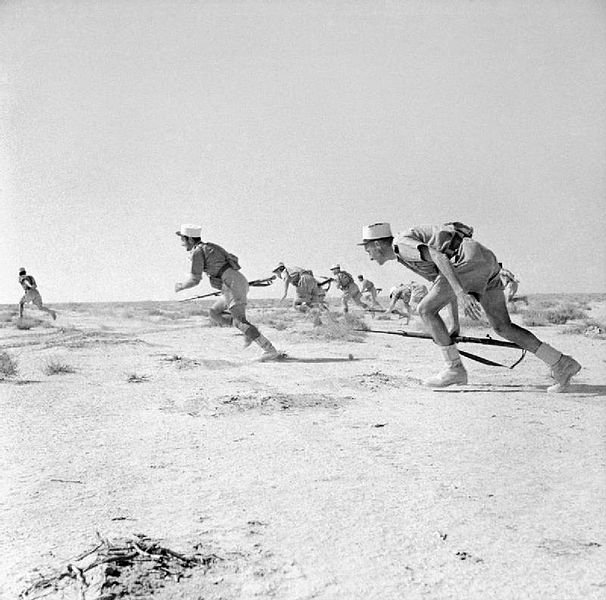 |
| Free French on the attack near Bir Hackeim, 12 June 1942 © IWM E 13313. |
Eastern Front: On vacation in Berchtesgaden, Adolf Hitler is full of hope and secret dread for the coming "decisive" summer offensive in the Soviet Union. The whole point of the attack, he muses, is to "clear the table" and win the war. "If I do not get the oil of Maikop and Grozny, then I must end this war," Hitler admits to his cronies.
The current attacks are not going well, let alone ones in the future. The assault on entrenched Russian defenses at the Crimean port of Sevastopol continues on 12 June 1942 without much progress by either side. The Soviets receive reinforcements when cruiser Molotov and destroyer Bditel'nyy evade the Axis blockade and deliver 2,314 soldiers, 190 tons of ammunition, and 28 artillery pieces to the besieged garrison.
German ground attacks continue without much success. In the critical northeast sector, LIV Corps continues its relentless attacks and loses 1957 men in the fighting of 11-12 June, but the Soviet defenders also are in bad shape.
The Germans, though, are determined. Super-heavy artillery piece "Dora" and eleven 420 mm mortars open fire on Fort Stalin, which guards the approaches to Severnaya Bay but have little impact. Finally, a dive-bombing attack by Junkers Ju-87 Stukas of StG 77 knocks out three of the fort's main 76.2 mm guns, and General Erich von Manstein's 11th Army assembles an attack force to take the fort for early on the morning of 13 June.
Resistance to superior orders is fairly common within the Wehrmacht, but everyone in uniform knows that it must be done "the right way." An example occurs today in Crimea. Luftwaffe General Wolfram von Richtofen has forbidden all air attacks in the Black Sea for fear of hitting Axis naval vessels. The local German naval commander, Vizeadmiral Gotting, vehemently disagrees, but von Richtofen's order is final and he will not listen to any complaints.
Accordingly, Gotting meets today in private with von Richtofen's naval liaison, Koneradmiral von Eyssen - who gives von Richtofen all of his naval information. Together they secretly agree that the order prohibiting Luftwaffe operations at sea is counterproductive and they jointly limit the order to a very small restricted zone directly off Crimea - without, of course, telling von Richtofen. Von Eyssen then coordinates this with Luftwaffe Oberst Wolfgang von Wild, who commands Lufftwaffe forces (Fliegerfuhrer Sud) operating over the Black Sea. Von Wild also agrees that von Richtofen's order is nonsense, and all three men subvert von Richtofen's direct order. This is the "right" way to disobey orders in the Third Reich and is done by different commanders throughout the war.
At Fuhrer Headquarters in East Prussia (Hitler is on vacation on the Obersalzberg), General Franz Halder has a disturbing conference with Vice Admiral Fricke and his aide. It is disturbing because, as Halder records in his diary, "Those people are dreaming in terms of continents." He writes that they "assume without another thought" massive German land victories that will obtain ports on the Persian Gulf and on the East African coast. "The problems of the Atlantic," Halder notes with incredulity, "are treated with off-hand superiority and those of the Black Sea with criminal unconcern." Halder, of course, has first-hand information on just how precarious the Axis position in the USSR really is.
Battle of the Pacific: Both sides are heading for home following the decisive American victory at Midway Island. Admiral Frank Fletcher, in command aboard USS Saratoga, is one day's sail from Pearl Harbor, while Admiral Nagumo is still two days' sail from Hashirajima. the Americans are eagerly publicizing their victory, while the Japanese are keeping their losses a guarded secret known only to the Emperor and a small number of high-ranking naval personnel.
USS Swordfish (Lt. Cdr. Chester C. Smith SS-193), operating northwest of Poulo Wai in the Gulf of Siam (later Gulf of Thailand), torpedoes and sinks Japanese freighter Burma Maru. The wreck is discovered in February 2017.
Japanese submarine I-21, operating off the east coast of Australia, torpedoes and sinks 5527-ton Panamanian coke freighter Guatemala while on the surface. The freighter is traveling in an eight-ship convoy from Newcastle to Whyalla, such convoys having been organized only recently due to the recent submarine assault on Sydney Harbor. HMAS Doomba picks up the crew, all of whom survive.
In China, the American Volunteer Group (Flying Tigers) has a big day. At dawn, the 1st Squadron shoots down four Ki-27 Nate bombers and five other twin-engine plans over Kweilin (Guilin, on the west bank of the Li River).
B-17s of the 5th Air Force bomb Lakunai Airfield and Vunakanau at the Japanese main overseas base of Rabaul.
 |
| NY Times, 12 June 1942. |
Battle of the Indian Ocean: Japanese submarine I-10 shells and sinks 2052-ton Panamania freighter Hellenic Trader in the northwestern Mozambique Channel near Bahla de Cruz. Later in the day, I-10 torpedoes and sinks 5064-ton British freighter Cliftonhall.
Japanese submarine I-16 torpedoes and sinks 3748-ton Yugoslav freighter Supetar in the Mozambique Channel near Cabo de Sao Sebastiao.
Japanese submarine I-20 shells and sinks 5063-ton British freighter Clifton Hall in the Mozambique Channel off Angoche, Mozambique.
European Air Operations: A small force of a dozen U.S. Army Air Force B-24 Liberators flying from northeast Egypt bomb the Ploesti, Romania, oil fields after taking off at 22:30 on 11 June. The bombing is extremely inaccurate due to poor weather and no appreciable damage is caused. The bombers encounter flak and a few enemy fighters. Altogether, the planes drop 24 tons of bombs, with a thirteenth bomber attacking the port of Constanta. The bombers then proceed on to Habbaniyah, Iraq, making this an early example of shuttle bombing. Four bombers make it to Habbaniyah, while the others land at other fields in Iraq and Syria. Four of the bombers land in Turkey and their crews are interned.
This is the first offensive mission by U.S. planes over Europe during World War II. General Dwight D. Eisenhower comments drily that the failed attack "did something to dispel the illusion that big planes could win the war." The bombers are from the Halverson Project 63, or HALPRO and have flown across the Atlantic for the mission. This small force forms the genesis of the 1st Provisional Bombardment Group (PBG) and the 376th Heavy Bombardment Group, completing another 450 missions.
The poor weather of spring 1942 continues and gets worse throughout the day on the Channel Front, but it is mild enough in the morning and early afternoon for some operations.
Group Captain Ken Gatward and navigator Flight Sargeant George Fern conduct The Beaufighter Raid on Paris, or Operation Squabble. This has been delayed for a month due to poor weather. This is a daring propaganda strafing run on a German parade down the Champs-Élysées that includes dropping Tricolor flags on prominent monuments (the Arc de Triomphe and the French Naval Ministry, currently being used as Kriegsmarine headquarters).
The two men take off from RAF Thorney Island in rain and clouds, but the weather clears sufficiently to carry out the mission. Flying at an extremely low altitude, the Beaufighter circles the Eiffel Tower at 12:27 and then heads for the Champs-Élysées. It turns out there is no German military parade (it hasn't begun yet), but the men drop the flags as intended. After strafing the Ministry building, the men return to RAF Northolt at 13:53. During the strafing run, the plane suffers a birdstrike, and the French crow is found in the starboard radiator. Gatward receives the DFC and Fern the DFM for their efforts.
RAF aircraft of Coastal Command engage in routine convoy patrols. They bomb and sink 1497-ton Swedish freighter Senta 30 nautical miles Cuxhaven, Germany (near the Weser River). There are no casualties.
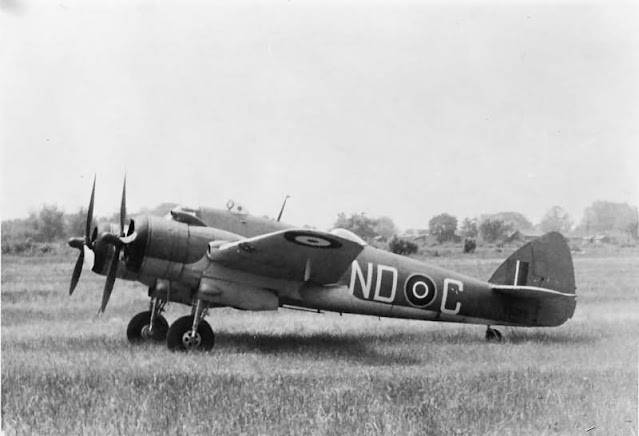 |
| Beaufighter Mk IC T4800 code ND-C of No. 236 Squadron RAF on the ground at Wattisham Suffolk 12 June 1942. |
Battle of the Baltic: Swedish 1046-ton Bojan hits a mine and sinks off Saßnitz, Germany.
Battle of the Atlantic: German cruiser Michel, operating off the coast of Brazil, on 6 June had spotted the disabled 7176-ton U.S. freighter George Clymer and launched its MTB Esan. The MTB torpedoed the freighter and the crew abandoned ship. However, the ship remained afloat, and the crew re-embarked. British armed merchant cruiser HMS Alcantara has remained in the vicinity of the badly damaged ship since arriving on the scene on 8 June, but today departs, leaving the freighter still afloat. It is assumed that George Clymer eventually sinks.
U-158 (Kptlt. Erwin Rostin), on its second patrol out of Lorient, torpedoes and sinks US 8192-ton tanker Cities Service of Toledo 20 miles east of the Trinity Shoal Buoy in the Gulf of Mexico. There are 15 deaths.
U-124 (Kptlt. Johann Mohr), on its ninth patrol out of Lorient, torpedoes and sinks 4093-ton British freighter Dartford south of Cape Race. There are 17 survivors and 30 deaths.
U-129 (Kptlt. Hans-Ludwig Witt), on its fifth patrol out of Lorient, torpedoes and sinks 9005-ton refrigerated cargo freighter Hardwicke Grange 120 nautical miles (220 km) north of Puerto Rico. There are three deaths and 78 survivors. The survivors are in four lifeboats for two weeks, and each lifeboat lands in a different country: Cuba, the Dominican Republic, Jamaica, and Haiti.
German 125-ton minesweeper M-4212 (formerly Belgian trawler Marie-Frans) hits a mine and sinks south of Vieux-Boucau-les-Bains, France. The mine was laid previously by French submarine Rubis.
 |
| Map of North African campaign, 12 June 1942. |
Battle of the Mediterranean: The British in the El Adem "box" are under intense pressure by General Erwin Rommel's 15th Panzer Division and give ground as the Germans attempt to break out of "the Cauldron." The 2nd and 4th Armoured Brigades retreat 6 km (3.7 miles) in disarray, leaving only the 29th Indian Infantry Brigade holding its ground. Rommel orders the 21st Panzer Division to join the attack on the 13th. A breakthrough here would open a pathway to Tobruk.
The Allies are only in as good a situation as they are due to the previous stout Free French defense at Bir Hakeim. Now that the fortress has fallen, the Germans can bring much greater pressure to bear on the British. Today, General Auchinleck praises the French, saying, "The United Nations need to be filled with admiration and gratitude in respect of these French troops and their brave General Kœnig."
While the intense Luftwaffe air campaign against Malta has eased in recent weeks, it remains in a precarious position due to supply shortages. Today, the Royal Navy begins Operations Harpoon and Vigorous, typical convoy missions to the embattled island. Harpoon sets out from Haifa, Palestine, while Vigorous begins at Gibraltar.
Convoy MW4 leaves Gibraltar heading east with six merchantmen (the British Troilus, Burdwan and Orari, the Dutch Tanimbar, the American Chant, and the tanker Kentucky) carrying 43,000 short tons (39,000 t) of cargo and oil. It is protected by Force X, which includes distant cover by battleship HMS Malaya and aircraft carriers Argus and Eagle.
The westward operation is a little more complicated. Convoy MW-11a embarks from Haifa with five merchantmen (British Ajax, City of Edinburgh, City of Pretoria, City of Lincoln, and Elizabeth Bakke) heading west. It is escorted by the 7th destroyer flotilla. This convoy has trouble immediately when Elizabeth Bakke is ordered back to port because it cannot maintain station due to overloading and its poor condition. Convoy MW11b departs from Alexandria, Egypt, with a tanker (Bulkoil), a merchantman (Potaro), and a decommissioned battleship (Centurion) being used as a freighter. It is escorted by five destroyers, four corvettes, and two rescue ships (Antwerp and Malines). There also is a third convoy from this direction that departs from Port Said, MW-11C, composed of freighters Aagtekirk, Bhutan, City of Calcutta, and Rembrandt.
The objective is to confuse and disperse the Axis defenses with all of these simultaneous convoys. In theory, this should enable maximum resupply of the island despite inevitable losses.
Unknown to the British, the Axis knows all about these operations already due to a major security breach by the US Military Attaché in Egypt, Colonel Bonner Fellers. Italian military intelligence (Servizio Informazioni Militare) has broken the American code and thus has deciphered Fellers' detailed reports to Washington. While not strictly Fellers' fault, better precautions could have avoided this. In any event, this incident proves that codebreaking during World War II was not just a one-way street that benefited only the Allies.
With the Axis ready and waiting, the attacks begin almost immediately. In the evening, 15 Junkers Ju 88 bombers of I Kampfgeschwader 54 based in Crete attack MW-11c. They score a near-miss on City of Calcutta, which slows it and forces the freighter to divert to Tobruk along with its towed MBT, escorted by two escorts. During the night, MW-11c slows to arrange a rendezvous with the other two convoys off Mersa Matruh.
Separately, U-77 (Kptlt. Heinrich Schonder), on its sixth patrol out of La Spezia, torpedoes and sinks the Royal Navy destroyer HMS Grove (L77) off Sollum, Egypt. The ship sinks in 14 minutes with 110 deaths and 79 survivors. Escort destroyer HMS Tetcott picks up the survivors.
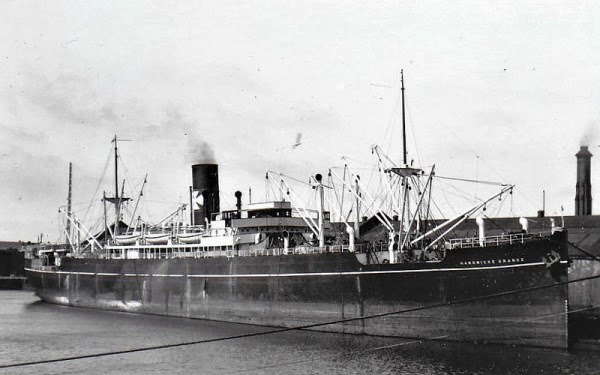 |
| British refrigerated freighter Hardwicke Grange, sunk by U-129 on 12 June 1942. |
Spy Stuff: U-202 (Kptlt. Hans-Heinz Linder), on its sixth patrol out of Brest, arrives off the south coast of Long Island, New York, in early-morning darkness and disembarks four German spies/saboteurs. The four men land at Amagansett. This is Operation Pastorius, one of a series of such operations planned to disrupt the economy of the United States. They are wearing German Navy uniforms to avoid being shot as spies if captured during the landing. However, upon landing and finding themselves alone on the beach, they quickly change into civilian clothes and bury their uniforms and other equipment.
A problem quickly develops when Coast Guardsman John C. Cullen spots the men posing as fishermen on a raft. Cullen also notices the submarine and sees that the men are armed. He approaches them, and the spies give Cullen $200 to keep quiet. Cullen takes the money but alerts his superiors later in the day, by which time the four spies have taken the LIRR into Manhattan.
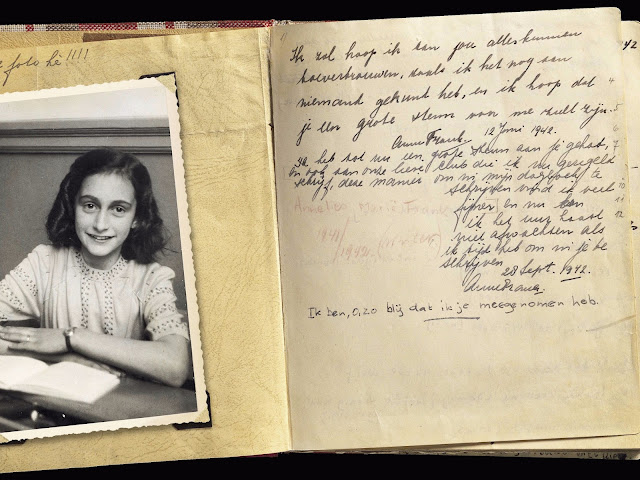 |
| The first page of Anne Frank's diary, written on 12 June 1942. |
Holocaust: In Amsterdam, Anne Frank is gifted a red-and-white plaid diary on her thirteenth birthday. The Franks, German Jewish refugees, have not yet gone into hiding. Her first entry begins, "On Friday, June 12th, I woke up at six o’clock and no wonder; it was my birthday." Later in the entry, she says, "I hope I will be able to confide everything to you, as I have never been able to confide in anyone, and I hope you will be a great source of comfort and support."
US Military: The US Army activates the 100th Infantry Battalion, composed of Japanese-Americans from Hawaii.
German Military: Oblt. Egon Albrecht becomes Staffelkapitaen of 1./ZG 1.
 |
| George Bush during World War II. |
Russian Homefront: Russian revolutionary Anna Yakimova dies in Novosibirisk, aged 86. She was a prime early agitator against the Tsar around the turn of the 20th Century.
American Homefront: In the evening, a tornado hits the southwest section of Oklahoma City near Will Rogers Airfield. Local sources (the Ada Evening News) report 21 dead, 25 critically injured, and 250 made homeless.
Future President George Herbert Walker Bush graduates from high school and immediately enlists in the U.S. Navy despite already having been admitted to Yale University.
Future History: Bert Sakmann is born in Stuttgart, German Reich. He grows up to become a noted cell physiologist who wins the Nobel Prize in Physiology or Medicine with Erwin Neher in 1991. As of this writing, Sakmann leads an emeritus research group at the Max Planck Institute of Neurobiology in Heidelberg, Germany.
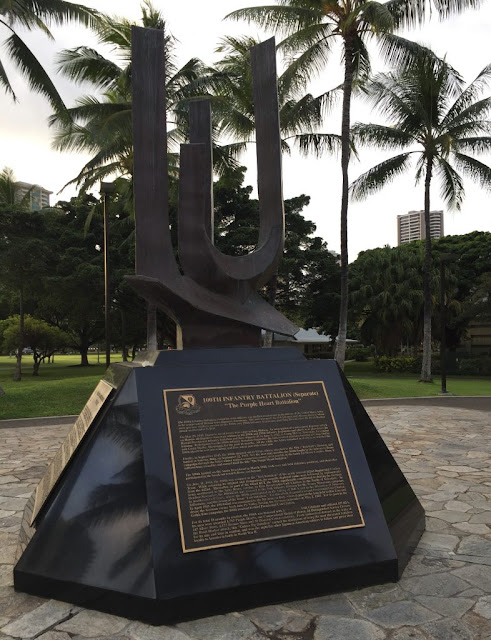 |
| Brothers in Valor Monument in Honolulu, Hawaii, commemorating the 100th Infantry Battalion and other Japanese-American units in World War II (Photo: Sarah Sundin). |
2022